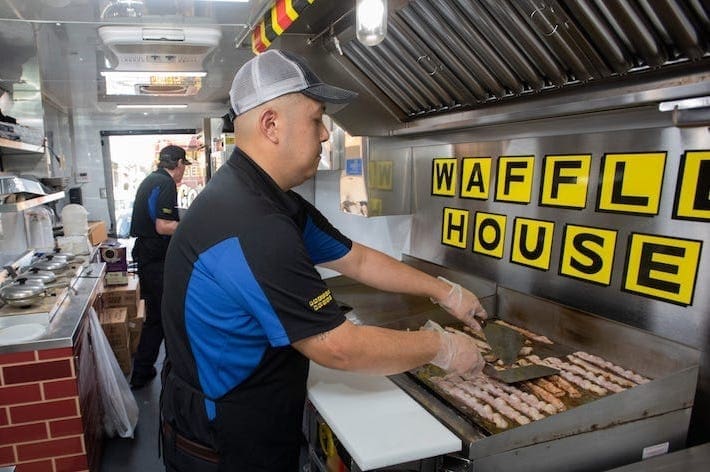Table of Contents
What I Learned About Lean Visual Signals from the Waffle House
In Lean methodology, a kanban chart—from the Japanese word meaning “signboard”—is a simple yet powerful visual management tool. Lean visual signals represent one of the most effective ways to manage performance in real time, eliminating waste and maximizing value-added activities. In our comprehensive Lean Six Sigma training programs, we emphasize how visual management transforms operations across manufacturing, healthcare, service industries, and even restaurants.
Lean Visual Management ensures operators spend time adding value to products or services rather than performing non-value-added tasks like searching for schedules, filling out reports, or leaving workstations to gather materials. When implemented correctly, visual signals communicate performance instantly without pausing for investigation or manual checks.
While some organizations overinvest in costly digital systems, others find surprisingly simple, effective solutions. One of the best real-world examples I’ve witnessed comes from an unexpected place: Waffle House. This iconic American restaurant chain demonstrates Lean visual management principles through an ingenious condiment-based ordering system.
How Does the Cook Remember All Those Orders?
Sitting in a Waffle House one morning, I was amazed by the cook’s ability to juggle multiple customer orders as they were called out. Initially, I assumed it was pure memorization. However, after watching closely, I noticed something remarkable implementing classic Lean principles.
Each plate acted as a physical kanban board, and condiments served as visual signals. The cook placed ketchup, mustard, or jelly in specific spots on plates—not randomly, but consistently and repeatably. This system was brilliant in its simplicity: condiment placement represented order details without paper tickets or digital screens.
The Waffle House Visual Management System
- Jelly Packet Signals: Right-side-up indicates white toast; upside-down signals wheat toast
- Butter Pack Indicators: One butter pack means one waffle; two packs signal two waffles
- Cheese Placement: Specific positioning indicates scrambled eggs with cheese or hash browns “scattered and covered”
- Plate Queue System: Plates line up in First-In-First-Out (FIFO) order, creating a visual production schedule
- Floor Markings: Wait staff stand on designated spots (single-point scheduling) preventing multiple simultaneous orders
- Buckboard Signals: Full lineup indicates capacity issues, signaling managers a second cook may be needed
That’s Lean Visual Management at its finest—simple, low-cost, incredibly effective, and eliminating seven types of waste simultaneously.

Simplify, Innovate, Automate: The Lean Hierarchy in Action
In Lean Six Sigma courses, we teach the hierarchy of improvements:
1. Simplify – Streamline the process using available tools
2. Innovate – Redesign the process when simplification isn’t enough
3. Automate – Apply technology as the final step, not the first
Too often, companies skip directly to automation, implementing expensive ERP or MRP systems to fix already broken processes. The result? Furthermore, even more complexity and longer lead times compound existing problems.
Waffle House didn’t fall into this trap. Instead, they simplified by asking: “How can we make the order process visual with what we already have?” The answer was right in front of them—condiments already present in the finished product.
Additionally, this real-world example demonstrates core Lean thinking: reduce waste, communicate visually, and empower people to focus on value-added work. Organizations across manufacturing, healthcare, logistics, and service sectors can apply these same principles.example of Lean thinking: reduce waste, communicate visually, and empower people to focus on value-added work.
Why Visual Management Works: The Science Behind Waffle House Success
Visual management succeeds because human brains process visual information 60,000 times faster than text. Consequently, Waffle House leverages this neurological advantage through their condiment-based kanban system. Instead of reading handwritten tickets or digital screens, cooks scan plates instantly, understanding requirements without cognitive load.
Key Benefits of Visual Management Systems
- Eliminates Searching Waste: Cooks don’t hunt for tickets or instructions
- Reduces Waiting Time: Orders flow seamlessly without information bottlenecks
- Prevents Defects: Visual signals eliminate miscommunication errors
- Improves Flow: FIFO plate queue ensures consistent service speed
- Enables Pull Systems: Production responds to actual customer demand
- Increases Transparency: Managers see capacity issues instantly
Organizations implementing visual management typically experience 25-50% reductions in lead time and 30-70% decreases in defects. Moreover, these improvements require minimal capital investment—often just reorganization of existing resources.
Applying Waffle House Lean Principles to Your Organization
You don’t need expensive software to implement effective visual management. Consider these practical applications inspired by Waffle House:
Manufacturing Applications
- Color-coded bins signal parts replenishment needs (similar to condiment placement)
- Floor markings designate workstation boundaries and material flow paths
- Shadow boards show tool locations at a glance
- Andon lights provide instant quality or capacity alerts
Healthcare Applications
- Patient boards display treatment status visually
- Color-coded wristbands communicate patient information instantly
- Visual standard work guides clinical procedures
- Kanban cards manage supply inventory
Office and Service Applications
- Digital kanban boards (Trello, Monday.com) visualize workflow
- Status indicators on desks show availability
- Visual metrics display team performance real-time
- Process maps on walls clarify workflows
The TAKT Time Connection: Matching Demand with Visual Flow
TAKT time—the rate at which products must be completed to meet customer demand—is another Lean principle Waffle House demonstrates perfectly. By visually managing their plate queue, cooks instantly see demand accumulation and adjust pace accordingly. When plates stack up (full buckboard signal), management knows to add capacity.
Similarly, organizations should implement visual TAKT time indicators showing whether production matches demand. This prevents both overproduction waste and customer dissatisfaction from underproduction.
Now I Challenge You to Look for Lean Visual Signals…
Lean tools aren’t limited to factories or offices—they’re everywhere if you know how to spot them. The next time you visit a busy restaurant, retail store, or service provider, observe how information flows visually.
Look for:
- Color coding systems organizing inventory or products
- Physical markers indicating positions or sequences
- Visual status indicators showing completion or readiness
- Queueing systems managing customer or product flow
- Information displays providing real-time performance data
Come back to this article and share in the comments how you saw Lean Visual Management used in unexpected places. It’s a great way to sharpen your eye for continuous improvement opportunities in daily life.
Related SSDSI Posts

Public, Onsite, Virtual, and Online Six Sigma Certification Training!
- We are accredited by the IASSC.
- Live Public Training at 52 Sites.
- Live Virtual Training.
- Onsite Training (at your organization).
- Interactive Online (self-paced) training,
About Six Sigma Development Solutions, Inc.
Six Sigma Development Solutions, Inc. offers onsite, public, and virtual Lean Six Sigma certification training. We are an Accredited Training Organization by the IASSC (International Association of Six Sigma Certification). We offer Lean Six Sigma Green Belt, Black Belt, and Yellow Belt, as well as LEAN certifications.
Book a Call and Let us know how we can help meet your training needs.





















Great example for visual signal. Can I use your example for one of my upcoming presentations here in Germany.
I am a lean coordinator for SME and my credo is to start lean just with common sense, rather than ordering a bus load of Mc Kinsey kids
Gerhard
Gerhard, Thank you for the compliment. Yes, you may use the example for your upcoming presentation in Germany.
Regards,
Kevin Clay, MBB
I often use a Waffle House menu in my classes do demonstrate the visual systems utilization. This is done in my lean Six Sigma training program, BOOT CAMP. One of my students brought a menu to me for this purpose. The color photos on the laminated menus allow everyone to order from a visual manner regardless of the ability to read the English language.
I love Waffle House. We don’t have them out here in Seattle.
I like your simplify, innovate, automate.
A quick Google search found several references with the terms in a different order (innovation at the end), but I agree with your ordering as the Pareto principle will get you every time, so why not get the biggest incremental innovations built into your automation instead of changing everything around after the fact.
Keep innovating!
Braden (@innovate)
Kevin, excellent observation by you and elegant solution by Waffle House. My dad loved to go there every week (or more frequently if he could get away with it). He noticed that same thing and brought it to my attention years ago. Your posting gets much better visibility!
Christopher, Thank you for the compliment. What a great memory to share about your Dad.